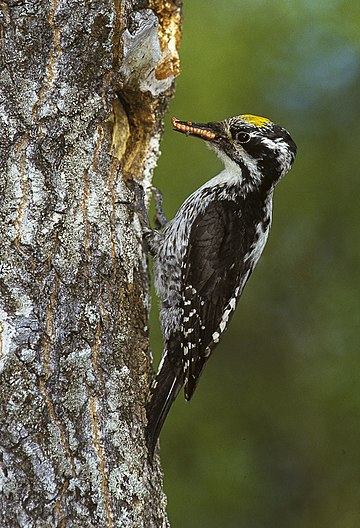Picoides is a genus of woodpeckers (family Picidae) that are native to Eurasia and North America, commonly known as three-toed woodpeckers.
| Picoides | |
|---|---|
 | |
 | |
| Eurasian three-toed woodpecker (P. tridactylus), adult male and the three-toed foot which lacks the first digit | |
| Scientific classification | |
| Domain: | Eukaryota |
| Kingdom: | Animalia |
| Phylum: | Chordata |
| Class: | Aves |
| Order: | Piciformes |
| Family: | Picidae |
| Tribe: | Melanerpini |
| Genus: | Picoides Lacépède, 1799 |
| Type species | |
| Picus tridactylus[1] Linnaeus, 1758 | |
| Species | |
|
See text. | |
Taxonomy
The genus Picoides was introduced by the French naturalist Bernard Germain de Lacépède in 1799.[2] The type species was subsequently designated as the Eurasian three-toed woodpecker (Picoides tridactylus) by the English zoologist George Robert Gray in 1840.[3][4] The genus name combines the Latin Picus for a woodpecker and the Greek -oidēs meaning "resembling".[5] The genus Picoides formerly contained around 12 species. In 2015 a molecular phylogenetic analysis of nuclear and mitochondrial DNA sequences from pied woodpeckers found that three existing genera (Picoides, Veniliornis and Dendropicos) were polyphyletic. After the resurrection of five monophyletic genera and the subsequent rearrangement in which most of the former members of Picoides were moved to Leuconotopicus and Dryobates, only three of the original species remained.[6][7]
Description
The males of all three species have yellow on the crown, though this feature is also present in some other pied woodpeckers, namely brown-fronted and yellow-crowned. The remaining color pattern of the plumage, structural features, and life habits are very similar to related woodpeckers of the Dryobates and Leuconotopicus genera.[8] The foot of all three species show an extreme adaptation to arboreal living by lacking the first digit, or hallux. It has been pointed out however that various species of pied woodpecker are similar in having a short first digit.[8] Two species of woodpecker in genus Sasia (not closely related) also lack the first digit.
Habits
As opposed to genus Dryobates, the three species of Picoides obtain most (some 85%) of their insect prey by pecking live or dead wood. The hairy woodpecker (Leuconotopicus villosus) for instance, obtains only 45% of its food by pecking wood, 30% from the surface of trunks and 25% at other places.[8]
Species
The genus contains the following three species:[7]
| Common name | Scientific name and subspecies | Range | Size and ecology | IUCN status and estimated population |
|---|---|---|---|---|
| Eurasian three-toed woodpecker | Picoides tridactylus (Linnaeus, 1758) Eight subspecies
|
across northern Eurasia from Norway to Korea. |
Size: Habitat: Diet: |
LC
|
| American three-toed woodpecker | Picoides dorsalis Baird, 1858 Two subspecies
|
western Canada, Alaska and the western United States |
Size: Habitat: Diet: |
LC
|
| Black-backed woodpecker | Picoides arcticus (Swainson, 1832) |
Canada, Alaska, the north-western United States |
Size: Habitat: Diet: |
LC
|
References
Wikiwand in your browser!
Seamless Wikipedia browsing. On steroids.
Every time you click a link to Wikipedia, Wiktionary or Wikiquote in your browser's search results, it will show the modern Wikiwand interface.
Wikiwand extension is a five stars, simple, with minimum permission required to keep your browsing private, safe and transparent.





